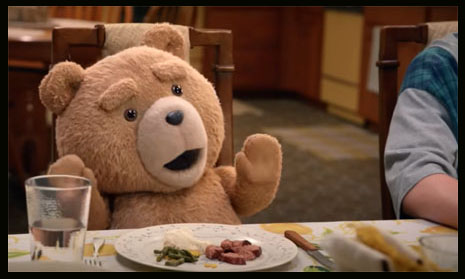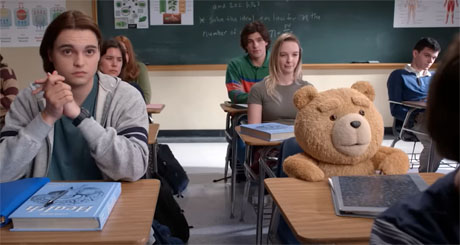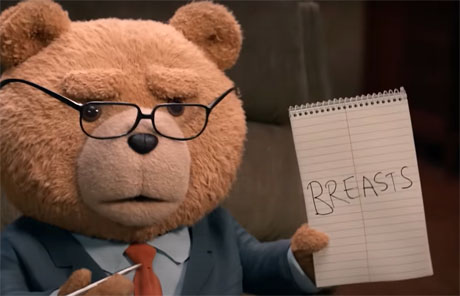
Seth MacFarlane’s foul-mouthed teddy bear Ted took movie theaters by storm in 2012 and returned with hilarious sequel Ted 2 in 2015. Now MacFarlane is taking us to the ’90s for the new, outrageous Ted prequel series, with the title character and a teen version of Mark Wahlberg’s John Bennett (played by Max Burkholder) navigating junior year of high school while living with cousin Blaire and Mom & Dad Susan & Matty. The seven episodes debut this Thursday January 11th on Peacock. Five-time Emmy-winning writers and executive producers Paul Corrigan and Brad Walsh (“Modern Family”), ViewScreen supervisor Brandon Fayette and visual effects supervisor Blair Clark take me behind the curtain of one of 2024’s first major shows in this Animation Scoop Q&A. (These interviews were conducted separately and were edited for length and clarity.)
Brad Walsh: After we knew we were going to be meeting with Seth and possibly working on this, I re-watched the movies and, with some distance, was like, “Wow. I can’t believe they’re getting away with this… and how well these jokes hold up.” And also how great that bear looked. And that was a while ago. That got me very excited for the meeting and exploring this character in new ways.

Paul Corrigan: Before I saw the movie, I heard a lot about how R-rated it was. I went in expecting that. What I didn’t expect was how sweet the friendship between John and Ted actually is — and how that’s the core of the movie and, hopefully, the core of the show as well.
Jackson Murphy: The visual effects of Ted the bear are amazing. We have scenes where there’s a slip ‘n slide, he’s running up and down the stairs, is thrown around at school and playing street hockey. Paul, what impressed you about what the visual effects team is able to pull off with how we see Ted over these episodes?
PC: They impress me with everything. One thing about working with Seth is: he has his visual effects team already in place, so we worked with people who had worked on the movies and had experience with Ted. Seeing them, day to day, make these things come to life was remarkable. The VFX Supervisor, Blair Clark… with all apologies to Seth… might be the most talented person on the show.
BW: He is as responsible for the look of Ted. That character is being made, in coordination with Seth — and Seth is obviously monitoring that process in a very hands-on way. These animators are creating Ted, and it’s really impressive. And by the way, all that tech is really impressive and fun to watch. There are also moments of low-tech that are great. For example, whenever Ted has to hand someone something or take something from someone, like money, that’s not animated. That’s literally a person wearing a little bear hand holding money handing it to the actor and then scurrying out of frame, which is really hilarious to watch.

JM: Brad, I saw Seth MacFarlane do an interview about a year and a half ago where he was talking about his career, and he teased this [series] and sort of said [something] along the lines of it being one of the most difficult things he’s ever been a part of. In working with him and your involvement, would you find this event series to be one of the most difficult things you’ve ever been a part of — because of the tech and what you’re out to do?
BW: Yeah. It really is. It’s about the tech and the post-production process. And Seth, to his credit, is meticulous and hands-on, and he really wants Ted to look great. And when Ted doesn’t look real, it takes you out of the show, and he never wants that to happen. We don’t want that to happen. So that involves a lot of refining and fine-tuning. That’s probably the labor of love he’s talking about.
PC: I think all that fine-tuning and all that labor that goes into these episodes is why it’s a seven-episode event series.
JM: With the two films and now this hilarious series, how do you feel the character of Ted has left a mark on comedy and visual effects/animation?
Blair Clark: Apart from being hilarious and cute, I think he is successfully viewed as a real actor in the cast and not a CGI character.
Brandon Fayette: The ability to bring Ted to life using Viewscreen has made its mark on both comedy and how we capture the performance of a digital character in new and creative ways. For the Ted TV series, Seth’s performance of Ted’s voice and facial expressions are happening live during the take. This means we can get more nuanced and comedic moments when he ad-libs dialogue along with other actors in a shot. Those natural bits that are the comedic gold that happen on the fly, and don’t have to be forced into a performance after the fact. The crew and team are also able to react in real time, making for more dynamic performances and camera angles.

Paul Corrigan, Brad Walsh and Jackson
JM: What do you love about what ViewScreen allows as far as being able to get a clear sense of Ted?
BC: Ted (The Series) was a test bed for ViewScreen which predominantly focused on generating a real-time representation of Ted during principal photography, viewable in camera to the Camera Operators to aid them in framing and tracking where Ted will be during a shot which was very helpful. It’s advanced way beyond that now and I’m looking forward to using it on future shows.
BF: ViewScreen simultaneously integrates visual effects and the real world. Because we could visualize the digital asset – Ted – in real time, we could treat him like any other actor or live action element in a scene. A major benefit of this is that the camera operator knows exactly how to frame Ted as he walks through a shot. We also used ViewScreen to capture Seth’s facial performance in real-time. It eliminated the guesswork required to get the comedic timing right because the the actors in the scene can see and respond to Ted as if he was any other actor.
JM: What special advancements (improvements upon the work that was done on the films) were made specifically for this event series?
BC: Ted needed to be updated for the series to adjust for the tech advancements the VFX companies had made since the features. Framestore and Tippett Studio worked closely together in creating a CG asset that could be shared between the two companies. Having two features and multiple promotional spots under their belt, the animators brought nuanced and extremely believable performances to this series that I think rivals the work done in the features.
BF: Viewscreen Studio was developed to be able to film Ted for the TV series in real time. We used it to render Ted directly in the camera operator’s viewfinder in real time, synced via timecode across three cameras. These tools are really powerful because they let Seth and the camera crew capture the right shots in fewer takes with the ability to see and react directly to objects in the frame that were previously invisible.
JM: What’s more challenging and why: a scene where Ted is walking down a hallway/street, or a scene in which he’s running, sliding or moving at a much faster pace?
BC: Running is always a bit more difficult with Ted, especially when running with an actor. Due to his size, trying to run at the same pace with his little legs and maintaining a believable gait can be challenging.
BF: Both present unique challenges. Ted could be walking down a hallway while holding his backpack and some props in his hand, while also holding a conversation with other actors moving through a crowd of people. Without a tool like Viewscreen which lets you actually see Ted walking down the hall, you’d end up with background actors walking through him, ruining the shot. Running/fighting type scenes are also challenging and require very specific choreography. The ability to see Ted in the shot, means that the camera operator can make sure to hold Ted in frame as the action unfolds frantically around him.

JM: How much of a factor is the lighting or indoor/outdoor conditions?
BF: ViewScreen Studio is designed to be used in any environment or condition where a camera operator can film. This includes many lighting conditions, both indoor and out. You are not limited to being in a controlled environment like on a stage. ViewScreen also delivers animation, lighting data, and other references from each camera to post production for use in editing as well as visual effects vendors as a first pass post-vis version of a shot that was directed on the day of filming instead of using a blank plate that has to be interpreted later.
BC: He looks good in pretty much every type of lighting, but give him a bit of backlit rim light and he looks amazing!
JM: Ted has some of the filthiest (and funniest) dialogue of any animated character. What is it like to make — and witness — this bear say what he says
BF: Ted is certainly the most foul-mouthed teddy bear of all time. Macfarlane, who is the voice of Ted, speaks Ted’s lines in real time with the actors in the scene. There were many times when a scene would be ruined by someone bursting with laughter in the middle of a shot. It was hilarious.
BC: Very often, it’s hard to keep from laughing during filming. And giving animation notes is always fun, “His lower lip needs to curl in more to sell the F and clearly enunciate the word F*ck”
- INTERVIEW: Strap In For “Mars Express” - April 30, 2024
- INTERVIEW: Jeff Fowler On “Knuckles” And “Sonic 3” - April 22, 2024
- INTERVIEW: “Inside Out 2” Director And Producer On Pixar Sequel - April 16, 2024


 January 5th, 2024
January 5th, 2024  Jackson Murphy
Jackson Murphy  Posted in
Posted in  Tags:
Tags: 






